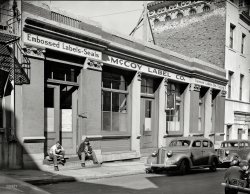
MAY CONTAIN NUTS

Search Shorpy
SHORPY ART

Framed or unframed, desk size to sofa size, printed by us in Arizona and Alabama since 2007. Explore now.
Join and Share
Ad-Free Shorpy
Shorpy is funded by you. Patreon contributors get an ad-free experience.
Learn more.

Recent comments
- Good choice
- Recent view
- Hudson’s Big Store
- Say what??
- Grapes?!
- A Beautiful Moment
- Such joy
- Bethune-Cookman University today...
- Yellow sky at morning
- Side Winder
- Air Quality?
- Sojourner Truth riot
- None were so blind(ed)
- The less famous sister
- Good ol' days?
- Rise and Fall
- Goo Goo Ga Joob
- Ticket Retention
- Not the only one
- Vagaries of War
- Killed by Amtrak
- Back to the Future
- Wanted --
- If you can't stand the light
- Centralized Traffic Control, I believe
- What's really happening
- Heckuva remote control!
- Sometimes — Things Go Bump!
- I SEE THE LIGHT
- Union Switch and Signal Company
Member Photos
The Shorpy
Print Emporium
Print Emporium
Search Shorpy
Search results -- 30 results per page
- Hop In: 1919
- ... you not talk to the guy who's actually working on your car.
Big Sign Shop Zooming in we see the name of the business that made ... Four Years Cranking Super is offering a lift in his 1915 Ford Model T Runabout. No starter motors on this model. He hand cranks it ... Posted by Dave - 07/08/2011 - 5:58pm -
![Hop In: 1919 Washington, D.C., circa 1919. "Washington Battery Co., L Street." We saw the garage earlier in this post. National Photo Co. glass negative. View full size.
Before the Insurance ExcuseThey asked politely that you not talk to the guy who's actually working on your car.
Big Sign ShopZooming in we see the name of the business that made the sign. Like it.
Pick Me UpIs this the ancestor of all pickup trucks?
Also: note the sign. No talking to the mechanics.
Hard Four Years CrankingSuper is offering a lift in his 1915 Ford Model T Runabout. No starter motors on this model. He hand cranks it and then gets in.
Rear deck and bulb type horn have been replaced with aftermarket pickup bed and manual horn. Practical pickup style not offered by Ford until 1925.
The BIG SIGN SHOP, Inc.On my best day I couldn't photograph something like this and get the clarity that it shown in this photo.
Brought to mindThis vehicle reminded me of the plastic model car kits my brother and I used to put together in the late forties, very early fifties during long summer days with no school. They were usually (very) antique old-time cars which we could not conceive of being road-worthy, which we had never seen and which we usually messed up due to the plastic cement which dissolved the plastic and the enamel paint which was difficult to apply neatly. Also each and every little part had to be attached, sometimes with a heated metal object to secure wheels, spokes, etc. The kits were sold in dime stores for a dollar or less. Just for the halibut, I decided a minute ago to look them up on the interweb. There are no more $1 car models, more like $20 and up, and the ones we had are long gone. I first heard about Stanley Steamers and Model T Fords via those plastic do-it-yourself car models. Remember plastic bubbles and magic growing rocks? All kinds of cheap crap to keep the kids busy in the summer. Good times.
Such a spindly little thingIt's the scrawny 98 pound weakling of pickup trucks, compared to the 2-ton behemoths of today.
Pick Em Up TruckI can't get past the sign with the words "any information desired will be cheerfully given". As if you would expect to get info delivered in a grouchy manner.
Buying a car?This reminds me of the last time a dealer sold me a car. He insisted that the car he was selling me is a demo and nothing was wrong with it. After having problems with the car he sold me I went to his workmen and asked them for a computer printout and sure enough the car was in a major accident! "We Respectfully request costumers to refrain from talking to workmen any information desired will be cheerfully given by floor superintendent."
[That Bob Mackie was kind of a blabbermouth. - Dave]
Highway PioneersMy first modeling experience was building some of the styrene Highway Pioneers models made by Revell. I built a bunch of them and had a lot of fun in the process. They were not terribly durable, at least in my young hands, but I loved them nevertheless. The distinctive feature that I remember, like OTY describes, was the way the wheels were attached. You were supposed to heat a slot screwdriver tip over a flame, and use it to melt the end of the axle. This formed a tip at the end like a nailhead that kept the wheel on. It was clever, by you had to be careful not to melt the axle into the wheel. No two hubs ever looked quite the same, but it worked.
(The Gallery, Cars, Trucks, Buses, D.C., Natl Photo)](https://www.shorpy.com/files/images/30828u.thumbnail.jpg)
- Turning Point: 1913
- ... to vote as equals to men as well. But it wasn't until 1915 when finally female servants would get their right to vote.
I am in ... There is a cool looking emblem on the radiator of the car to the extreme left. Anyone recognize it? I love all the motion blur in ... Posted by Dave - 08/22/2020 - 8:35pm -
- Getting Ready to Ride
- Circa 1916 "convertible"
Model T touring car Nice example of the 1914 Ford. Just a year old by the date of the Indiana 1915 license plate.
The 'hat brimmed' or billed front fender with the ... Posted by chugalug - 09/22/2011 - 11:52pm -
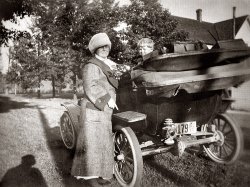
- Neoclassical Gas: 1919
- ... of the Palace is MOSTLY an exact replica of the 1915 version. The wall of the Palace itself facing the colonnade was originally ... war that happened.
[He must be standing behind the car. -tterrace]
Redux That's the original Palace of Fine Arts Rotunda, ... Posted by Dave - 02/09/2017 - 12:14pm -
![Neoclassical Gas: 1919 San Francisco, 1919. "Hudson Biddle & Smart touring limousine at Palace of Fine Arts." Home, Fido! 5x7 glass negative by Christopher Helin. View full size.
Not exactlyThe 1960s reconstruction of the Palace is MOSTLY an exact replica of the 1915 version. The wall of the Palace itself facing the colonnade was originally fully decorated with freestanding and engaged columns identical to those of the colonnade, and the central doors facing the entrance to the rotunda were elaborately framed. This wall was rebuilt smooth, dull and blank (presumably to reduce costs) and its bareness is now screened by trees; the central doors now have minimal moldings framing them. The original concept as executed made the crescent walk behind the colonnade a much richer, more enclosing, visual experience than it is today. A bit of the pergola which crowned the original wall is visible in this photo.
Theft insurance.Love the chain and padlock on the spare tire.
During the big warThe lad on the right has a navy pea coat with chief petty officer rating. Some kids even had a full uniform to wear. Last war that happened.
[He must be standing behind the car. -tterrace]
ReduxThat's the original Palace of Fine Arts Rotunda, built of wood and "staff" (a mixture of plaster and straw) for the Panama-Pacific International Exposition of 1915. Beloved by San Franciscans, it was the only structure retained afterward. The building deteriorated so badly over the next 50 years that it had to be demolished in the fall of 1964. An exact replica was built in its place from permanent materials and was completed two years later.
Early SUVwith integral roof rails and requisite pooch.
FashionistaShe can also be seen here.
Hudson Sold ValueWhen this car was new autos often had mechanical troubles that made them difficult to drive. Hudson was a medium priced car that was both powerful & reliable for its time.
The Super Sixes as shown in this picture were the first production car to feature a counterbalanced crankshaft allowing higher engine speeds, more power & longer life than was typical at the time.
Another feature was a cork clutch which ran in oil that was smooth, long lasting and did not slip. Other types of clutches often jerked, burnt out or slipped. Every Hudson except the first & last years of production was equipped with a cork clutch.
With these mechanical advantages and a moderate price, Hudson sold a lot of Super Sixes and some were fitted with elite bodies such as those by Biddle & Smart.
(The Gallery, Cars, Trucks, Buses, Chris Helin, Dogs)](https://www.shorpy.com/files/images/SHORPY-1086.thumbnail.jpg)
- This Land Is Your Land: 1939
- ... Fort Smith & Western RR was in receivership in 1915, again in 1931 and ceased operations on Feb 1, 1939. In Sept '39 Missouri ... either, just the drums that came on the wheels. This car will seat 2-3 at the most (no rumble seat). Great Photo.
1927 Model T ... Posted by Dave - 07/24/2012 - 9:38pm -
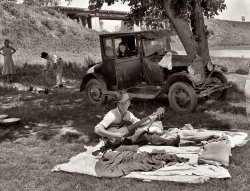
- Flapper's Up: 1920
- San Francisco circa 1920. "Studebaker touring car and biplane at airfield." With the fur possibly about to fly. 6½ x 8½ ... in 1920, this stretch of filled shoreline (created for the 1915 Panama Pacific International Exposition) served as an embryonic municipal ... Posted by Dave - 07/07/2015 - 6:09pm -
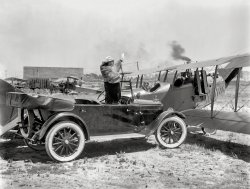
- Dort Duo: 1923
- "Dort car in San Francisco." An automotive brand that was not long for this world in ... carriage manufacturer that dated to 1884, started autos in 1915, lasted until 1924. But the Dort name lives on today. There is a Dort ... parts to the Gray Carriage Company of Chatham Ontario from 1915-25 for their Gray- Dort autos. Dort abruptly left the automobile business ... Posted by Dave - 03/06/2015 - 10:42am -
![Dort Duo: 1923 "Dort car in San Francisco." An automotive brand that was not long for this world in 1923. 5x7 inch glass negative by Christopher Helin. View full size.
The Other Motor CityDorts, Stars, Durants, and, of course, Flints.
On the perhaps biased basis of these photos, there certainly seems to have been an awful lot of products of the "Vehicle City", Flint Michigan, rolling around on the streets of San Francisco in those long-ago days.
The name lives onConsidering how quickly some early automobile companies disappeared the Dort did ok. Started by a carriage manufacturer that dated to 1884, started autos in 1915, lasted until 1924. But the Dort name lives on today. There is a Dort Highway in Flint, MI. When I was young I lived not too far from there.
A big shiny DortLooks like it will take more than that to get a smile from that girl.
Wow.Great car but I'm so entranced by the beautiful passenger that I can hardly focus on anything else.
Almost the sameThis 1923 Dort Six sold for $15,400.00 in 2011.
Fabulous Photo! The Background...The Car...The People!
Re: Wow.The eyes.
Almost General MotorsDort autos were built by Josiah Dallas Dort who had been a partner with William Crapo Durant, the founder of General Motors. Their partnership in Durant Dort Carriage Works was disolved after Durant formed GM. Dort then went on to create Dort Motor Company. He supplied mechanical parts to the Gray Carriage Company of Chatham Ontario from 1915-25 for their Gray- Dort autos. Dort abruptly left the automobile business in 1925 stranding the Gray family without a source of parts and their firm subsequently went out of the auto business also.
HeadlampsLamps seem to have Ford script. Didn't know Ford supplied other makes.
[They didn't. - Dave]
The Eyes have it!Those eyes are mesmerizing. Time is of little consequence. After almost a century those eyes reach into your soul. Immediately, they were the first thing I noticed about the photograph.
(The Gallery, Cars, Trucks, Buses, Chris Helin, San Francisco)](https://www.shorpy.com/files/images/SHORPY-267-02.thumbnail.jpg)
- Flo and Chuck: 1918
- ... on, at first glance it might be a (by 1918) antique car, but the interior background and the assortment of levers makes me think ... at State barracks.
Nutley, NJ, Rigo, Charles P., born 1915 in New Jersey, son of Paul H. and Ethel W. Rigo, white, male (only child); ... Posted by Dave - 08/19/2012 - 4:36pm -
![Flo and Chuck: 1918 New York. March 16, 1918. "Florence A. Young and Chas. P. Rigo." 5x7 glass negative, George Grantham Bain Collection. View full size.
Zamboni?Anyone have any idea what the heck they are riding on? Maybe a old school zamboni?
Curls & CarsUntil the 20s, young boys frequently wore their hair this long, until it was time for first grade. I'm trying to figure out what they are sitting on, at first glance it might be a (by 1918) antique car, but the interior background and the assortment of levers makes me think this was some kind of internal trolley in a large store or factory, or perhaps underground like the tunnels in Chicago.
GoldilocksI think the little hippy is way too young to drive and Flo sure has some funky leg warmers.
PutteesFlo is wearing puttees for some reason, so she probably is also wearing trousers of some sort beneath her dress. Puttees are leg wrappings made of long strips of cloth, adopted by several armies during the WWI. The Brits were hugely big on puttees, while the US went for leggings, though puttees were also known in the US Army. Bob and Ray were known to work puttees into their radio routines.
She presents a very sturdy appearance...a woman in charge of something: Chas P. Rigo?
Flo-MowAnother shot of Florence on that riding mower. This was at the Sixth International Flower Show at Grand Central Palace on Lexington Avenue.
Hey Tut!(He's my brother.) There are pictures of our dad with very similar girly hair when he was just a little squirt. Our mom frequently makes fun of his mom for having his hair that long.
1920 CensusThese may be our folks from the 1920 Federal Census:
Trenton, NJ, Young, Florence A., head of household, female, white, 42, single, born New Jersey, occupation: custodian at State barracks.
Nutley, NJ, Rigo, Charles P., born 1915 in New Jersey, son of Paul H. and Ethel W. Rigo, white, male (only child); Paul H. is a florist with his own shop; the grandparents of Charles were from Germany.
No matches from the New York census. This photo must be of a brief encounter. Flo cuts the grass and Charlie's dad sells flowers.
Lady Gardener?The more I look at the photo of Flo and her outfit, the more I think she must have been "Florence A. Young, The Lady Gardener". Her costume certainly gives the impression of a person doing outdoor work -- you don't need puttees while dusting the crockery. Was she the Charlie Dimmock of her time?
[The leggings are because it's freezing cold outside. At 8 a.m. that day in New York it was 23 degrees, up from a low of 14. - Dave]
That's my Pop-PopCharles P. Rigo was my grandfather. His father was president of the New York Floral Society so his presence at this show makes sense. I do not know who Flo is, but I am sure going to try to find out.
(The Gallery, G.G. Bain, Kids, NYC)](https://www.shorpy.com/files/images/26356u1.thumbnail.jpg)
- Snellenburg's: 1912
- ... to waste an afternoon in!
Looks like a Lozier That car looks like a ca. 1911 Lozier. Pictured below is a 1911 Model 51. The Lozier ... and built luxury cars starting in 1900 and ending in 1915, when the company went bankrupt.
+101 Below is the same view from ... Posted by Dave - 07/09/2018 - 2:59pm -
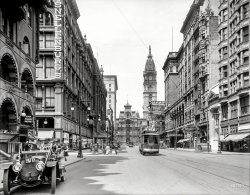
- Washington à Go-Go: 1917
- ... glass negative. View full size.
One fine motor car I sure hope one of our eagle-eyed regulars can ID that auto!
... Evening Star reports on the go-go experiment in October 1915 and its implementation in November of the same year.
Same architect. ... Posted by Dave - 05/06/2014 - 8:44am -
![Washington à Go-Go: 1917 1917. "District of Columbia -- traffic Stop & Go signs." From the birthplace of that musical genre, perhaps the earliest visual representation of "go-go." Raleigh Hotel in the background. Harris & Ewing Collection glass negative. View full size.
One fine motor carI sure hope one of our eagle-eyed regulars can ID that auto!
Newspaper RowForeground is the 1300 block of Pa. Ave NW. Visible at top left is the Washington Post building (1339 E St.) and the Munsey Trust Building (1327-29 E St., housing the Washington Times), seen previously on Shorpy here and here.
Haynes RoadsterThe Haynes was manufactured in Kokomo, Indiana, from 1905 until 1924 by Elwood Haynes and brothers Edgar and Elmer Apperson. Before that, they produced the Haynes-Apperson from 1896 as the first automobile manufacturer in Indiana and one of the earliest in the United States.
Another pic of the same car is here.
License and registration, pleaseAs seen from a different angle, this car has license number 41441. According to the Sept. 17, 1916 Sunday Star, that tag was issued in early September 1916 to the Haynes Motor Company for use on a demonstration vehicle.
HaynesThis is actually a 1917 or 1918 Haynes Light Twelve Cloverleaf Roadster.
Newspaper Row, ctd.And don't forget the Evening Star, in the background.
That hotelI believe the hotel in the background is the famous Willard Hotel, not the Raleigh. It still stands.
[It's the Raleigh. -tterrace]
Test-TestThe Evening Star reports on the go-go experiment in October 1915 and its implementation in November of the same year.
Same architect.I understand FloridaClay's confusion. Both hotels were designed by architect Henry Janeway Hardenbergh who apparently liked the style. The Willard is a decade older and a floor shorter than the Raleigh.
(The Gallery, Cars, Trucks, Buses, D.C., Harris + Ewing, Streetcars)](https://www.shorpy.com/files/images/SHORPY_13275a.thumbnail.jpg)
- The Club: 1916
- ... Lions and Tigers games.
Change Nobody locks their car.
No hydrant standardization When were hose connections on hydrants ... Club (founded in 1887), built the building shown in 1915, and invited in anyone important to the auto industry. There were so many ... Posted by Dave - 09/14/2014 - 12:25pm -
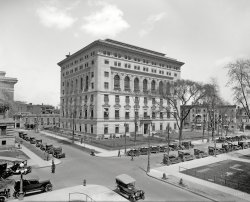
- Six in the Park: 1929
- ... still driving them.
Palace of Fine Arts Part of the 1915 Panama-Pacific International Exposition, sort of a world's fair for the ... picture is 86 years old. You can place the woman and the car in period, but not him.
Today's Palace of Fine Arts Many San ... Posted by Dave - 02/15/2015 - 9:32pm -
![Six in the Park: 1929 San Francisco, 1929. "Hudson Super Six." Strangers when they met, until he took her for a ride. 5x7 inch glass negative by Christopher Helin. View full size.
A Robust RideHudsons were well constructed and solidly middle-class cars. That sedan probably weighs as much as four of today's Formula 1 racers and thanks to its torque-rich, long stroke engine, could probably accelerate smoothly from a walking pace to 45 MPH in ... oh, I don't know -- how much time have you got?
[Curb weight of this five-passenger sedan was about 3,700 pounds, or two and a half Formula 1 cars. -Dave]
The Joads' JalopyIt was a Hudson Super Six that starred as the Joads' decrepit jalopy in John Steinbeck's signature 1939 novel, "The Grapes of Wrath." After ten appalling years of the Great Depression, it must have been hard to know which were more worn out: 1920s autos or the hapless Americans who were still driving them.
Palace of Fine ArtsPart of the 1915 Panama-Pacific International Exposition, sort of a world's fair for the City, the only remaining buildings. Lovely part of the City!
A la modeI am very interested in menswear, especially business wear, and it is fascinating to me how contemporary the fellow in this photo looks. The cut of the suit, the shoes, the haircut - all could as easily be 2015, even though this picture is 86 years old. You can place the woman and the car in period, but not him.
Today's Palace of Fine ArtsMany San Franciscans would be surprised to learn that the beautiful and iconic Palace of Fine Arts in the City's Marina District is actually a 1965 replica of the original from the 1915 Exposition.
Us kids, roaming around San Francisco in the early '60s, often played at the old Palace. It was in terrible shape, actually rotting away with the poor quality burlap and plaster finish falling off the wood lath beneath. It had never been intended to last longer than the expo and wasn't permanent.
Fortunately, San Francisco couldn't let it go and so they completely rebuilt the Palace on site in permanent materials.
Here's a photo by Kevin Cole:
(The Gallery, Cars, Trucks, Buses, Chris Helin, San Francisco)](https://www.shorpy.com/files/images/SHORPY-252-02A.thumbnail.jpg)
- Automobile Row: 1918
- ... use around the City today.
Speedster I believe the car next in line is a Vauxhall, can not determine the Model.
The Car in ... Automobile Co. as its West Coast representative.
Circa 1915 Rose became the Chalmers agent for all of northern California. He took ... Posted by Dave - 05/14/2016 - 12:52pm -
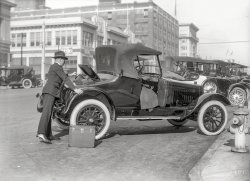
- Big Wheels: 1917
- ... to impress his clients. Sitting in his expensive touring car before entering the White House to advise President Wilson about the ... notably the Model T Ford, which didn't go electric till 1915 and didn't lose its brass till 1917, but the majority "got modern" in that ... Posted by Dave - 08/23/2012 - 5:35pm -
![Big Wheels: 1917 Washington, D.C., circa 1917. "Soterios Nicholson in auto." This "well-known Greek attorney" had a long and occasionally eventful career in Baltimore and Washington. Harris & Ewing Collection glass negative. View full size.
Driver overboard!Who knew cars used to come with life preservers?
Spokes personInteresting,, the back wheels have 12 spokes , the front only 10. You would think the brakes would stress the front rims too. Or are there no front brakes?
[Probably not. - Dave]
BrakesVery few cars had front and rear brakes in the teens. Many cars were capable of high speeds but 25 to 30 mph was about the average cruising speed so rear brakes were considered adequate. On Model T Fords, the service brake was a band inside the transmission.
Photo OpI guess he had this picture made to impress his clients. Sitting in his expensive touring car before entering the White House to advise President Wilson about the situation in Greece.
Hornblower!Note the electric horn. That's quite early for this period, when most horns were still bulb-style. Presumably then it had electric lights and a starter too. A well-optioned car indeed.
White Car, White HouseThis car is a White, of circa 1913 vintage -- a milestone year for many cars as they not only made the switch to electric lights and horns, but also did away with brass lights, radiators, etc. Not all cars made this evolutionary jump, most notably the Model T Ford, which didn't go electric till 1915 and didn't lose its brass till 1917, but the majority "got modern" in that year. 1913 also saw the beginnings of a cowl, extending over the firewall and dashboard, which afforded a bit more protection from the elements.
A Weighty MatterThe additional spokes of the rear wheels allow these wheels to bear the additional weight of both multiple passengers and their luggage. The front axle and wheels will bear a smaller proportion of any passengers and luggage.
Put another way, if three 150 pound men and two heavy trunks are transported in the rear and on the back, suddenly you have 500 plus pound of additional load that is mostly over the rear axle.
The Rolls-Royce Silver Ghost (40/50) was another automobile that used a different number of spokes front and rear for the same reason. The longer the wheelbase the more weight the rear axle will have to support for passengers and luggage.
(The Gallery, Cars, Trucks, Buses, D.C., Harris + Ewing)](https://www.shorpy.com/files/images/17449a.thumbnail.jpg)
- Leftward Ho: 1919
- San Francisco, 1919. "Cadillac touring car at marina." Putting rubber to the road with a variety of treads. 5x7 glass ... would that bare land on the left have been the site of the 1915 Panama Pacific International Exposition?
[Yes; in this area ... Posted by Dave - 10/02/2015 - 1:07pm -
![Leftward Ho: 1919 San Francisco, 1919. "Cadillac touring car at marina." Putting rubber to the road with a variety of treads. 5x7 glass negative by Christopher Helin. View full size.
HingedNote the "fat man's steering wheel," with hinged spoke, that could be swung out of the way for ease of entry.
HoldoverI don't know about the rest of the country, but in West Virginia we still had to know our hand signals to pass a driving test in 1975. Many motorcycles still didn't have turn signals and believe it or not, quite a few old cars and trucks were still around with only a single stoplight. Never had to turn my palm rearward for left or right turns. Came naturally for stops though.
Good Roads MovementAt first I thought that window sticker said "Yes Cool Roads" but then I realized it's Good Roads. Here's some info:
https://en.wikipedia.org/wiki/Good_Roads_Movement
Location clueOver on the left is the sign and tower of the Ghirardelli chocolate factory, so my guess is that we're probably on Bay St. and the empty block is an as yet undeveloped part of Fort Mason.
Hand Signals As the owner of a 1930 roadster lacking turn signals, I can attest to the reactions of modern drivers to hand signals such as that pictured here: they wave back.
Illegal Hand SignalWhere, in the South, I passed my driving test 67 years ago, one had to have the palm facing rearwards in hand signals. The palm was said to be lighter in color.
Scary StuffI used to ride motorcycles with no turn signals well into the 90's, it was always a little scary and iffy approaching turns and stops. People rarely knew about hand signals and what they meant, which made me extra cautious about turns and stops. It felt like I was riding with a big old target painted on my back.
It's Chestnut Street, not Bay Street.This would be Chestnut St, which is the original 1913 route of the Lincoln Highway It was the northernmost street in this area and had a streetcar line on it. The bare land was developed into the Marina District neighborhood, with Chestnut being the main commercial strip.
[Which would place the row of similar houses in the background on the 2900 block of Van Ness Ave., where at least one of them seems to remain. -tterrace]
Formerly the Fair?If this is Chestnut Street, would that bare land on the left have been the site of the 1915 Panama Pacific International Exposition?
[Yes; in this area specifically, "The Zone," the area of amusement concessions. -tterrace]
(The Gallery, Cars, Trucks, Buses, Chris Helin, San Francisco)](https://www.shorpy.com/files/images/SHORPY-711.thumbnail.jpg)
- Long Branch Park: 1905
- ... fall of rapid transit Little did they know: since about 1915 it's been all downhill.
The park remains - no so the railroad The ... spot in the outer Syracuse area for events such as car shows, ethnic festivals, picnics and exhibits.
To Chicago on my dime ... Posted by Dave - 08/20/2012 - 10:22am -
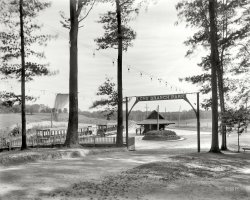
- Speed Maniac: 1920
- ... glass negative. View full size.
Mix in a Race Car? I guess Tony stayed back in the barn, muttering imprecations at his ...
While working on a Ham and Bud comedy in the autumn of 1915, he suffered a compound fracture of his left leg and was unable to work ... Posted by Dave - 12/10/2014 - 10:48am -
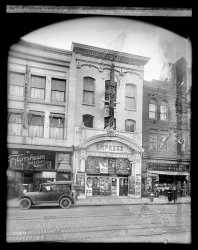
- Cat House: 1935
- ... is the obvious knob-and-post wiring job.
Kiddie Car What is this? It looks like a toy car of some sort, it has a license ... between 1926 and 1938, was similar—but larger. The 1915 AC prototype is seen below.
Steelcraft made various ... Posted by Dave - 02/05/2014 - 11:01pm -
![Cat House: 1935 Circa 1935. "Reuben Lovett house, Princess Anne County, Virginia. Structure dates to 1790." 8x10 negative by Frances Benjamin Johnston. View full size.
Traces of EleganceThough it's lost its portico and tablature, this house still reflects its original upscale aspirations: three (or probably four) chimneys, a relative wealth of windows, etc.
Clearly still inhabited, or else that is the most patient cat in the Old Dominion. [Two cats, actually. - Dave]
One interesting detail is the pair of brackets awaiting reinstallation of the window box. Another, more troubling to the rehabilitator, is the obvious knob-and-post wiring job.
Kiddie CarWhat is this? It looks like a toy car of some sort, it has a license plate and the stylized logo seems vaguely familiar.
I grew up near this place. (Kempsville)But if it's the building I think it is, it was torn down in 1977 or 1978 to make a strip mall shopping center (Providence Square, at the corner of Kempsville and Providence Roads, directly across from its twin, Fairfield Shopping Center). I remember the house having just an incredibly beautiful, large oak tree in the front yard, and the most beautiful staircase structures I had ever seen when they tore the front of the building off (three days to take it down; they went slow). If you check Google Maps, it has the entrance to the shopping center listed as Profair Way; the house was facing Providence Road and Profair Way was basically where the original drive to the house was, with the house just slightly south of the P but before the center itself. This picture would have been taken slightly north of due east, which the shadows agree with if this was an morning in the early winter time frame. Providence Road would be off to the right from the picture, and Kempsville Road (modern Kempsville Road, at least) would be behind the photographer.
If it's the same building (and I lived in the area as it was built up to become a pretty dense suburbia), it had obviously been repaired and lived in until about a decade earlier or even the early 1970s, but it had fallen into disrepair again by it's destruction.
I've often thought about how old that building looked, and how old it must have been when they tore it down.
The entire area, of course, is now part of the City of Virginia Beach (all of Princess Anne County became part of Virginia Beach back in the early 1960s), but this is the Kempsville area of the city.
I'm so sorry, Dave, that I can't report it as having been on Pleasure House Road; that's on the opposite side of Virginia Beach.
Kiddie carYes! I noticed that too. Mack truck. Think it's a pedal car? I grew up with "cars" however my little brother had a fire truck in the early '70s.
That's an early Mack Truck logoKiddie Division.
A Bulldog, to be preciseAn earlier post of mine was too obscure to make the cut, but that pedal car was modeled after the Mack AC introduced in 1916. The Mack AP, produced between 1926 and 1938, was similar—but larger. The 1915 AC prototype is seen below.
Steelcraft made various pedal car versions of the Mack AC, including this one, which closely matches the one in the yard:
(The Gallery, Cats, F.B. Johnston)](https://www.shorpy.com/files/images/SHORPY_05503a.thumbnail.jpg)
- Mr. Right: 1920
- San Francisco in 1920. "Oldsmobile touring car." Its dapper driver signaling either "hello" or a right turn. 5x7 glass ... the Oldsmobile mark the site of the recently-demolished 1915 Panama Pacific International Exposition fair grounds. Same view today ... Posted by Dave - 10/21/2014 - 1:00pm -
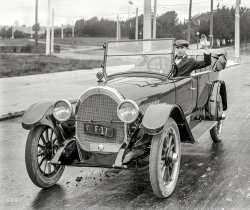
- A Tattered Tire: 1922
- ... Circa 1922 in San Francisco, this aging Chalmers touring car needs a new shoe. Since we're at the Maxwell-Chalmers dealer, why not take ... automobile business in 1914, and an Oakland franchise in 1915. The Chalmers dealership is listed there from 1916 - 1922.
Although ... Posted by Dave - 11/28/2014 - 12:23am -
![A Tattered Tire: 1922 Circa 1922 in San Francisco, this aging Chalmers touring car needs a new shoe. Since we're at the Maxwell-Chalmers dealer, why not take a look at the new models? 6½ x 8½ glass plate from the Wyland Stanley collection. View full size.
Maxwell is still with usMaxwell-Chalmers was having a roller-coaster year in '22, sales had been growing fast but bad word-of-mouth from some less than rigorous engineering, cash flow issues from the Chalmers merger, and the '21 recession all worked together to put the company in deep doo-doo.
Thankfully the board recruited a first-rate Automotive guy to turn things around, Walter Chrysler took most of his pay in stock options and had the finances solid enough inside a year that he could launch a new line with his name on it.
Hurry it up, boysLet the men replace the tire; she's got places to go!
Rose and fellThe 1922 Crocker-Langley city directory lists exactly one dealer for Maxwell & Chalmers autos, the Lou H. Rose showroom at 1230 Van Ness.
The printing of this directory must have taken place shortly before the ill-fated merger of the Maxwell & Chalmers companies. Perhaps Lou Rose could see the end coming, because the 1923 directory contains no entry for Rose's showroom or any other Maxwell dealer.
Also, the survey of Van Ness Auto Row buildings makes no mention of Rose or 1230 Van Ness.
This touring cardates from about 1913. Chalmers, located in Detroit, made quality cars from 1908 to 1923. Pictured below is a restored 1913 touring as well as a 1922 ad similar to the one in the dealer’s window.
Would you guys get on with it!The expression on the face of the lady in the driver's seat says it all.
Right hand driveWhy is this vehicle right hand drive? Didn't they change from RHD to LHD in California in the 'teens? Maybe it was a pre-change over model car?
[It's a circa 1913 model. Cars of the era were a mix of right- and left-hand-drive. By 1920, most auto makers had settled on left-hand drive. - Dave]
A Rose By Any Other NameRose's automobile business remained at the same location in 1923. In the 1923 Crocker-Langley City Directory the business is simply listed as "Campe-Rose Co 1230 Van Ness Av" without a marque name. The next year Rose's name is missing from the listing with the business shown as "Campe Geo 1230 Van Ness Av" in the city directory under the heading "Automobiles."
Prior to the Chalmers Dealership the address was occupied by Steven G. Chapman's automobile business in 1914, and an Oakland franchise in 1915. The Chalmers dealership is listed there from 1916 - 1922.
Although the Chrysler dealership in San Francisco is shown on Market Street in 1925, in 1926 it is at 1200 Van Ness, in the same block where Rose's business was previously located. The appearance of this building, erected in 1911, has been altered according to the Auto Row Survey.
The Auto Row survey's purpose was to list the surviving automobile related structures that are present in the survey study area. I believe the survey fails to mention the 1230 Van Ness address because either the building that was there in 1922 had been torn down or the address was incorporated into an existing structure along the street and the address is no longer used. Looking on Google Maps there are now only two buildings in the 1200 block of Van Ness on the even numbered side of the street.
(The Gallery, Cars, Trucks, Buses, San Francisco, W. Stanley)](https://www.shorpy.com/files/images/SHORPY-147-01A.thumbnail.jpg)
- The Paddy Wagon: 1919
- Washington, D.C., 1919. "Franklin Motor Car Co. police van." The latest in law enforcement. Harris & Ewing ... truck was a surprise. Doing a little research, I found a 1915 ad for the Franklin Commercial Car Company showing what looks like this truck minus the 'police' bodywork and ... Posted by Dave - 08/09/2014 - 4:08pm -
![The Paddy Wagon: 1919 Washington, D.C., 1919. "Franklin Motor Car Co. police van." The latest in law enforcement. Harris & Ewing Collection glass negative. View full size.
Something missingI wondered what the large circle on the front of the truck was. It looks like something was missing or removed. A quick Google revealed this:
A common question amongst passengersAnybuddy gat a knife?
ConfusedI always thought Franklin only made idiosyncratic luxury cars with air-cooled engines and wood-reinforced frames, so this truck was a surprise. Doing a little research, I found a 1915 ad for the Franklin Commercial Car Company showing what looks like this truck minus the 'police' bodywork and mentioning its air-cooled engine, which leads me to believe it was in fact a product of the Franklin Motor Car Company (as stated). But I'm blowed if I can find any mention of trucks in the FMCC's history on line. Can one of Shorpy's resident experts relieve my confusion?
[Trucks were produced by Franklin's Commercial Division. -tterrace]
"Paddy", he sezA term used to describe either the occupants or the operators.
This old Irish cop preferred the term "prisoner transport', but the difference was lost on the young constables.
Worra, worra.
(The Gallery, Cars, Trucks, Buses, D.C., Harris + Ewing)](https://www.shorpy.com/files/images/SHORPY-14284a.thumbnail.jpg)
- Great-Grandpa & Grandma with Old Betsy
- Old Betsy is the car not the woman [wink] ... a "1908 International" according to the picture ... rutted tracks that passed for roads in 1907 to at least 1915. Secondly, the High Wheeler buyers, used to horses, could relate to buggy ... Posted by Gen Xer - 11/19/2007 - 11:21am -
![Great-Grandpa & Grandma with Old Betsy Old Betsy is the car not the woman [wink] ... a "1908 International" according to the picture (International Harvester). My great-grandparents were farmers in Iowa.
International HarvesterInteresting to note at this point in automotive development, that the vehicle is little more than a small engine attached to a wagon. Looks like it's mostly made of wood.
[It's a wagon chassis without a body. International Harvester made agricultural equipment before getting into the truck business. - Dave]
Mine in IA, too!My grandparents and great-grandparents where farmers in Iowa, too! I can't recall if my grandpa was an IH or John Deere guy though. I think IH!
Isefire Where in Iowa? Mine are in the southeast near Carroll.
"History must be written of, by and for the survivors."
Anonymous
International High WheelerThe International High Wheeler was available with several body options, a far-sighted idea in 1907. You could have a full Buggy body (seating front and rear), or a pickup-type wagon body with just a front seat -- and you had the choice of optional hoods for both styles.
Yes, the frame was all wood, and the large buggy wheels had two appealing features. Firstly, they were practical for rutted tracks that passed for roads in 1907 to at least 1915. Secondly, the High Wheeler buyers, used to horses, could relate to buggy wheels, making the transition to motorized transport a little easier.
Over 4,500 High Wheelers were produced, with a very large number still surviving.
However, the Ford Model T was cheaper, faster, lighter, and more powerful -- and it was the death knell for the High Wheeler. IHC lost its way in motor vehicle design, temporarily, under the Model T onslaught, but then found its niche in motor trucks.
(ShorpyBlog, Member Gallery, Cars, Trucks, Buses)](https://www.shorpy.com/files/images/gparentscar.thumbnail.jpg)
- 13th Street: 1925
- ... they came down with the change of seasons.
Awnings and Car Those awnings, and of course, the Model T really help date this image. ... managed the former Donald Hotel in Washington. From about 1915 to 1934, [sic] the small residential hotel was located at 1012 13th St. ... Posted by Dave - 09/11/2011 - 1:27pm -
![13th Street: 1925 Washington, D.C., circa 1925. "1008-1010-1012 13th Street." View full size. National Photo Company Collection glass negative.
Awning ChasmThis was before air conditioning, so I imagine those awnings served a very real purpose. I would think they came down with the change of seasons.
Awnings and CarThose awnings, and of course, the Model T really help date this image. Without them you might think it was taken in the 19th Century. I must say, however, that the awnings sure spoil the dignity of the architecture, managing to make it look like a pretty lady in a frumpy and rumpled dress.
Any vacancies?I'd love to move right in. This is a great picture, the building, the awnings, even the boy idling on the steps!
I'm sure those awnings darken the rooms, but they'd definitely help keep things cooler!
A-MasingThe Mason work on the facades of the buildings is absolutely magnificent. An art that certainly isn't practiced in today's architecture. I'm also digging that Mansard roof on the far right. Has that Norman Bates look.
The DonaldThis row of buildings, dating from ca. 1890, are beautiful variations of Victorian brick rowhouses. The masonry of the facade is made of pressed and molded brick, a smoother (and more expensive) form of masonry typically reserved for the street-facing sides of city rowhouses. What I find most curious about this photo is the matched carved-stone door portals: the buildings are each unique but the portals are identical.
At the time of this photo, this row of houses were combined as a small residential hotel: The Donald Hotel. Thus, the matching awnings on all the units.
Prior to service as a hotel, these houses saw use as residences of several congressmen (still trying to figure out which ones).
This entire row was razed in the 1930s to make way for a new firehouse. Now this location is in the heart of the K-street lobbying district.
Washington Post, Jun 9, 1889
Building Permits: Emmons & King, four brick dwellings, 1010 and 1012 Thirteenth street northwest, and 1010 and 1012 alley in rear of same, $12,000.
Washington Post, Feb 17, 1929
Adam A. Weschler purchased 1008-10-12 Thirteenth street northwest from Clara B. Campbell. Mr. Weschler will establish his place of business at this location in a new building.
Washington Post, Aug 27, 1930
Three lots at Thirteenth and K streets northwest were brought by the District yesterday for $120,000 as a new site for a fire house to replace two now located elsewhere in the downtown area. Engine Co. No. 16, now at Twelfth and D streets northwest, and Truck Co. No. 3, now at Fourteenth street and Ohio avenue northwest, will share the building to be erected on the newly acquired site at 1008 to 1012 Thirteenth street.
The land, on which now stands the old Donald Hotel, was bought from Adam A. Weschler through the Munsey Trust Co., after considerable negotiation by Maj. H.L. Robb, Assistant Engineer Commissioner, who weighed the merits of three proposed locations at length before final selection of the site was made.
Washington Post, Feb 23, 1975
Alice Fenwick Fleury, 88, who helped operate two family-owned hotels in Leonardtown, Md., and Washington, died Thursday of congestive heart failure.
Along with her husband and daughter, Mrs. Fleury managed the former Donald Hotel in Washington. From about 1915 to 1934, [sic] the small residential hotel was located at 1012 13th St. NW. The family then moved the hotel to 1523 22d St. NW, and operated it until 1956, when it was sold.
My neighborsI live very close to this location, and I walk by here every day. The firehouse, Engine 16, Tower 3, that is now located here is actually quite lovely. And, I believe they won an award for the best firehouse (responder?) in DC last year.
(The Gallery, D.C., Natl Photo)](https://www.shorpy.com/files/images/31269u.thumbnail.jpg)
- Over the Edge: 1923
- ... glass negative. View full size.
Stephens car The spare tire cover seems to indicate that it's a Stephens . The S ... leadership, the company entered the automobile business in 1915, when it began building commercial bodies to go on Ford chassis. In 1916 ... Posted by Dave - 03/13/2014 - 9:59am -
![Over the Edge: 1923 Mrs. Dorothy Holland, 20 years old, of Baltimore, lies in Georgetown University Hospital suffering from internal hemorrhages as a result of an automobile in which she was riding going over a 30-foot embankment near the Virginia end of the Chain bridge at 6 o'clock yesterday morning. ... According to the police, the accident was the result of an all-night party that began at 1 o'clock yesterday morning ...
"Auto wreck -- July 30, 1923." Last seen here six years ago in this post. National Photo Company Collection glass negative. View full size.
Stephens carThe spare tire cover seems to indicate that it's a Stephens. The S on the inside of the door hints this way also.
I'll betThe jazz was hot at that party, though!
Ouch!The broken steering wheel spokes and the rigid steering column could ruin your day very quickly on the ride down that embankment.
Collapsible steering column standards wouldn't be mandated in the U.S. until 1968 - forty-five years after this accident.
Stephens Salient SixFrom the book Minneapolis-Moline Farm Tractors by Chester Peterson, Jr. and Rod Beemer, MBI Publishing Company, Osceola, WI, Page 10
"George W. Stephens became president and controlling owner of MPC [Moline Plow Company] in 1882. Under his leadership, the company entered the automobile business in 1915, when it began building commercial bodies to go on Ford chassis. In 1916 the Stephens Motor Works at Freeport, Illinois, began production of MPC's passenger cars.
"The company's automobiles were named The Stephens Six and initially came in two models: the Model 65, which was a five-passenger touring design, and the Model 60, a roadster. In 1918 the new overhead valve six was introduced as the Salient Six and it, too, came in two styles: the three-passenger roadster, Model 70, and the Model 75, a five-passenger touring car.
"The Stephens Salient Six engine had been produced by Root & Vandervoort Company (R&V) of Moline, Illinois, since its first use in 1918. The MPC purchased the engine business of R&V late in 1920. At that time Moline was taking about 80 percent of this engine production for its tractors and Stephens autos.
"The medium-priced Stephens automobiles had much finer body work than was ordinarily seen in the trade. Between 1918 and 1924 several additional models were introduced. Yet on July 23, 1924, the company announced that it would cease production of the Stephens automobile. Total production of the Stephens auto is placed at approximately 30,0000 of which only 20 examples are known to exist."
Separately, the Chain Bridge, which the car was traveling upon, was the seventh bridge built in the same location. The first bridge collapsed; the second burned after six months; the third was destroyed by flood; the fourth was removed to build a new bridge; the fifth also collapsed; and the sixth was swept away during a flood. This seventh bridge lasted from 1874 - 1939. The current bridge is the eighth one built, but it is built upon the piers erected in the 1870s.
(The Gallery, Cars, Trucks, Buses, D.C., Natl Photo)](https://www.shorpy.com/files/images/SHORPY_09167u.thumbnail.jpg)
- Memorial Lamppost: 1909
- ... film plates that were dipped in it.
Lincoln, The Car and The Man A writer I knew had written a book with the above title. He ... but had been delayed both by fundraising issues and by the 1915 demise of the sculptor, Karl Bitter, run over by a car as he left the ... Posted by Dave - 05/05/2014 - 10:54am -
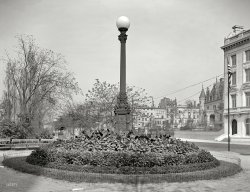
- A Merry Young Soul: 1917
- ... the Detroit area has what is an exceedingly rare auto, a 1915 Cole 4-40 touring car, which might be the only one left in the world. That is the original color ... Posted by Dave - 06/02/2016 - 7:50pm -
![A Merry Young Soul: 1917 San Francisco circa 1917. "Cole Eight Toursedan at Golden Gate Park." Latest epistle in the Shorpy Bible of Brobdingnagian Broughams. View full size.
Shadows and FDRI'm surprised the photographer's shadow is so prominent. Guess I presume that professional photographers are more diligent about aspects like that - distracting things in foreground, etc. I'm guessing this shot wasn't used for any published purpose.
[Would be easily dealt with in preparing the photo for newspaper publication, as was the intent. Lighting, background and composition were more important factors for the shoot itself. -tterrace]
Living FossilA friend of mine here in the Detroit area has what is an exceedingly rare auto, a 1915 Cole 4-40 touring car, which might be the only one left in the world. That is the original color - not every early car was black.
Always wanted to put a bumper sticker on it "Powered By COLE."
Cole 8The Cole was a high quality auto made in Indianapolis. Before WWI there were only a few autos that had the unusual V8 engine. There were earlier V8s but it was Cadillac that developed in great secrecy and "revealed" the American V8 in 1914 (a little later used in Oldsmobiles and Chevrolets.
In '24 a Cole was the Indy 500 pace car but that was getting close to the end of the Cole company's life. There are about 60 Coles left in existence.
(The Gallery, Cars, Trucks, Buses, Chris Helin, San Francisco)](https://www.shorpy.com/files/images/SHORPY-978.thumbnail.jpg)
- Ready to Roll: 1918
- San Francisco circa 1918. "Franklin touring car." Latest specimen in the Shorpy Sideshow of Air-Cooled Oddities. 5x7 glass ... first photo below shows the buildings surrounded by the 1915 Panama Pacific International Exposition. The comparison detail from the ... Posted by Dave - 01/07/2017 - 1:45pm -
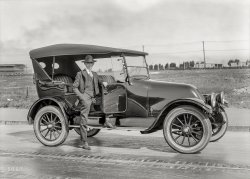
- The H Train: 1919
- 1919. "Cadillac touring car at rail stop." H Line streetcars of the San Francisco Municipal Railway. ... by the Panama Pacific International Exposition (PPIE) of 1915.
The concrete trolley wire poles with their ornate cast iron tops are ... Posted by Dave - 10/01/2017 - 8:20pm -
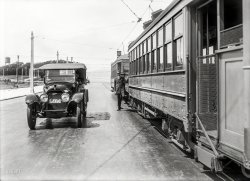
- Buggy Buffet: 1919
- San Francisco, 1919. "Grant Six touring car at Alta Plaza Park." Manifesting a variety of conveyances for young and ... with both the word and the date were first issued in 1915. -tterrace]
Love the description Shorpy has the best ... to be Renstrom.
The entrance to the park behind the car appears to be at Washington and Steiner streets:
(The ... Posted by Dave - 05/04/2017 - 11:35am -
![Buggy Buffet: 1919 San Francisco, 1919. "Grant Six touring car at Alta Plaza Park." Manifesting a variety of conveyances for young and old, in this latest psalm from the Shorpy Bible of Bygone Buggies. (Footnote: running-board doormat.) View full size.
Dealer License PlatesThe earliest dated ones that I have seen.
[California dealer plates with both the word and the date were first issued in 1915. -tterrace]
Love the descriptionShorpy has the best descriptions. "Shorpy Bible of Bygone Buggies". I also particularly liked "Forgotten Phaetons" and "Brobdingnagian Broughams".
And The Dealer Is ...Frank O. Renstrom, who was previously seen here. The driver seems to be Renstrom.
The entrance to the park behind the car appears to be at Washington and Steiner streets:
(The Gallery, Cars, Trucks, Buses, Chris Helin, Kids, San Francisco)](https://www.shorpy.com/files/images/SHORPY-1164.thumbnail.jpg)
- The Old Mint: 1940
- ... as one-story building. Passed into private hands in 1915. —HABS, 1940
March 1940. "McCoy Label Co., old U.S. Sub-Treasury ... View Larger Map
Unlabled Parking The car closest to the guys on the steps is a 1937 Dodge 4-door Trunk Sedan with ... Posted by Dave - 04/21/2014 - 12:10pm -
